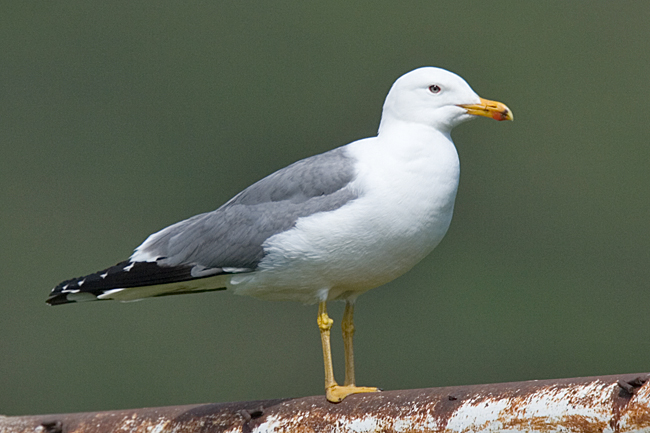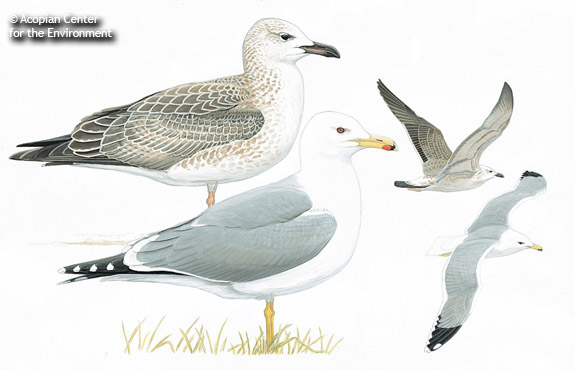Armenian Gull
Armeniermöwe in Israel
The Armeniermöwe (Larus armenicus ) is a species of bird in the family of gulls ( Laridae ). It is considered by some authors as a subspecies of Mittelmeermöwe with which it hybridizes locally. Based on studies of mitochondrial DNA, as well as behavioral and plumage characteristics of their cheap but since the late 1990s, numerous other authors species status. The breeding colonies of Armeniermöwe are mountain lakes in Asia Minor and the Caucasus, where the species in the countries of Armenia, Turkey, Iran and possibly in Georgia occurs. The wintering areas are to the east of the Mediterranean, in the extreme north of the Red Sea and perhaps the Persian Gulf.
- 7.1 Literature
- 7.2 External links
- 7.3 Single Documents
Description
The Armeniermöwe heard with a body length of 52-60 cm and a wingspan of 120-140 cm of the medium sized Larus species. It is very similar, but overall slightly smaller and darker on the upper side of the closely related Mittelmeermöwe. The eye is often darker and the long 41-57 mm Jaw acts relatively short and blunt.
Adult clothes
Have adult birds in breeding plumage a dirty yellow orange to yellow bill with a red Gonysfleck and black markings in front of the beak tip (also in breeding plumage ) can be pronounced as subterminales band often. The tip of the beak is often brightened somewhat, so that the beak acts in four colors. In winter dress red Gonysfleck of the black ring drawing is usually largely obscured. The iris is quite variable. In a majority of the birds she is spotted dark or dark, a lower percentage shows a bright iris. In winter, it is dark and yellow dress only a few birds. The orbital ring is red. The legs are both in breeding and in winter dress yellow, in winter more easily into greenish, in summer often more orange yellow.
The head, chest and underside plumage is in breeding plumage white. In winter plumage the head is fine, neck and sides of the chest are a little stronger brown dashed lines. The top is medium gray, the white wing trailing edge and on the arm wing relatively wide. The hand wing shows a relatively compact, often triangular -looking, black lace, which may extend to the outer primary coverts. A white Subterminalfeld is most pronounced only on the outer tenth primary feather and the white primaries peaks are relatively narrow so that they are sometimes almost completely removed in the summer. The tail is completely white.
Immature dresses
The youth dress Armeniermöwe similar to the Mittelmeermöwe, but dashed tight especially among less hand and the dark dotted eye mask is less conspicuous. In the first winter dress, the similarity remains, but especially the large coverts remember with their relatively uniform pattern to the first winter plumage the herring gull. In addition, the inner hand wing shows a bright field. In the second winter show up on the back already gray feathers, the body plumage appears brighter than in the first winter and the rump is already pure white. The shield springs often have extended to white lace and stitching and the beak is brightening. In the third summer the black is on the wing tip often more extensive than in adult birds and there are some remnants of a dark tail band to detect. Birds in the fourth winter can no longer be distinguished from adult animals.
Voice
The voice of Armeniermöwe is described as shrill and hoarse and less melodic than the Herring Gull. The " shout " (long call) sounds - as well as in the Caspian - frantic and excited. Typical of the Caspian " Albatrosspose " but is missing.
Distribution and population
The distribution of Armeniermöwe in Asia Minor and the Caucasus extends over parts of the countries of Armenia, Turkey and Iran, possibly the kind occurs in Georgia. The total population is estimated at 23000-25000 breeding pairs. 98 % of the stock breed in four colonies. The largest with 11000-13000 pairs located on Lake Sevan in Armenia. Another on Arpilich reservoir was once the most, but included in 1999 - probably due to interfering activities and Absammeln of eggs - only 15 breeding pairs. In Turkey, the species occurs at 2000 breeding pairs on the island Carpanak Adası in Van Gölü ( Lake Van ), 500 pairs also breed on Lake Tuz in Central Anatolia and 40-50 on Beyşehir Gölü. The Iranian inventory includes about 4000-5000 pairs that breed only at a lake. The population trend was negative 1930-1960, this was followed by a sharp rise locally and a sharp drop in recent years.
Hiking
The Armeniermöwe is a partial migrant, probably on the train to the course of major rivers towards the coast and major estuaries follows. The main wintering areas are in the eastern Mediterranean, where arrive in Israel from August up to 60,000 copies. The highlight of the arrival is there mostly between October and December. The largest collections were there from 15,000-20,000 birds. In smaller numbers, the species overwinters in northern Egypt. Winter verifications are from Sicily, the Black and the Caspian Sea and the Gulf States (Oman, United Arab Emirates, Bahrain) and the northern Indian Ocean. Possible confusion with the subspecies L. f barabensis the gull can be especially the evidence in the south and east of the Arabian Peninsula questionable.
Habitat
The Armeniermöwe occurs outside the breeding season in coastal and inland waters, but breeds only in mountain lakes up to 1900 m altitude. The colonies are there in reed beds, on rocky or grassy shore areas or in agricultural areas.
System
The Armeniermöwe 1934 was described by Sergei Alexandrovich Buturlin as a subspecies of Larus taymirensis - a Möwentaxon whose nominate today as a subspecies of the gull (Larus fuscus ), or " Tundramöwe " (L. ( f ) heuglini ) is considered. In the wake of the controversial discussions about a reorganization of the " white -headed gulls " within the genus Larus then represented in the 1960s, some authors the view armenicus should be given species rank. This was justified, inter alia, by Pierre Devillers with the extraordinary beak drawing. If this is also quite came to a consensus, specific studies have been conducted by Dorit Lieber and Andreas Helbig in 1999. These showed that in the main distribution area of armenicus a predominant percentage of all birds has a stable combination of features, which clearly demarcated from michahellis. To the west of the range, however, there are many birds of an intermediate type, which is often not unique to you because of the phenotype. This indicates a mixture of the two forms, which is supported by genetic findings. Mitochondrial haplotypes, which are typical for michahellis, are common in western Turkey, no longer to be found in the eastern part of the Anatolian highlands, however. This suggests on the one hand to a reproductive isolation, on the other hand to a gene flow from michahellis to armenicus out. It is supposed that the Armeniermöwe on a stage of development between subspecies and biological, and forms the sister taxon of Mittelmeermöwe. Their is therefore a corresponding rank in the taxonomy assigned to.










